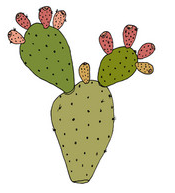

Cacti are a part of me
This is the story how cacti came into my life

I was 7 years old when I got a bowl of cacti from an aunt of mine. They were Echinopsis (which I didn't know). I tried to find out how to take care of them, and read that they need a dry, gritty soil. So I mixed potting soil with sand, and I tried to grow them in that mixture. Naturely (I didn't know any better) I continued to water them, and it didn not took long for them to leave this place and go to cactus heaven. But the seed was sown...

At my primary school, in some classes, there were cacti in the window sill. Echinopsis and Chamaecereus silvestrii. I received cuttings, and I tried to grow them at home. I still made the same mistake, having no idea how to take care of them. I did give less water, but continued to do so also in wintertime. It was no success, but I never lossed my interest in them.

It was not till secondary school, when I got befriended with the school's Biology amanuensis (think of a laboratory assistant). His father grew cacti (which were lost during the second World War), and he gave me the key. Cacti (well, most of them) want a cool and dry(!) winter rest. From that moment, my plants grew better and they stayed alive (or better, I did not loose them anymore because of winter watering).

In 1981, I got my first greenhouse. At that moment, I did not know what to grow, so I had Echinocerei, Notocacti, Ferocacti, Mammillaria, ceroids. Oh, and also Opuntia's. The greenhouse was about 3.5 x 2.5 meter. As you can guess, the Opuntia's grew way to fast for such a small greenhouse. So they had to go. I collected more and more globular cacti. In 1991 I had to replace my greenhouse, and immediately built a bigger one in its place (3.5 x 4.5 meter). This quickly became filled with more Echinocerei, Ferocacti and ceriods. Within a few years, I had 4 options left.
1) stop collecting at that point
2) specialize (meaning get rid of all the cacti not belonging to my favourite genus at the time, Echinocereus)
3) expand the greenhouse (impossible, the garden was already filled for more than 75 % with my greenhouse)
4) find room somewhere else
I chose option 4, and built cold frames on a local allotment

In 1987, I built a greenhouse on my allotment, measuring 3 x 4 meters, and about 2,5 meters high. That was the maximum I was allowed! The greenhouse was well insulated, but heating it turned out to be a disaster. My gas cylinder was empty within a week, and I still couldn't keep the greenhouse to my desired temperature (8 degrees °C). So now what to do?
After doing some reading in books and literature, I deciced to try a selection of my plants without heat. That worked really well, and in 1988 I build my first cold frame. That measured around 14 meters, with a effective width of 2.2 meter! Now my collection really took off. In wintertime, some of the plants would be put in the greenhouse in different layers, and they would return to the cold frame in the spring. Pretty quickly I added another cold frame, and than another..
By 2002 I had 5 cold frames with a total of 200 square meters of glas, exclusing my two greenhouses! Watering them became a strenous task, taking me two full days (including the evening), with back breaking lifting pains and putting them back. Repotting had stopped, because I had no more space. The water in the local ditch (no rain or tap water) got poorer in quality every year (of with no water at all). And my paines were made of wood, and started rotting. As a result, lifting them became even harder, and leakage became a growing problem.
Because a small nursery couldn't be found locally, the family moved to Bemmel in 2012, where we found a small nursery with a biggish house and some land

In Bemmel I had a bigger greenhouse, with also vertical space. And where I could not grow Opuntia's, let alone Cylindropuntia's in my cold frame, I could now. And since a lot of Opuntia's can take cold (sometimes a lot of cold), I now decided to grow what I could not grow all these years because of space limitations. And I decided to grow Opuntia's. This site is about Opuntia's, Cylindropuntia's, Tunilla's, Maihueniopsis, Puna and their kin. I try to make as many pictures as I can, and put them on my site. The idea is that my site will grow in time to contain photo's of all the Opuntia's and related genera that I have.